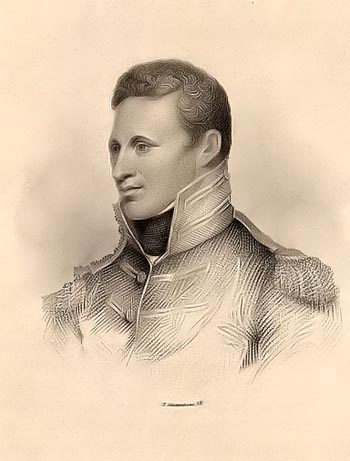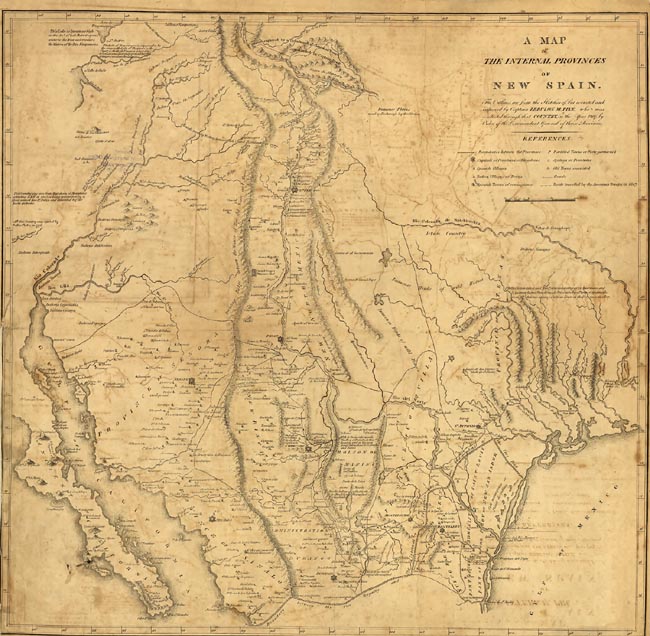Expedition of Zebulon Pike
![]()
This Site:
The History of Texas: Zebulon Pike Expedition(Previous Section: War With Spain Avoided)
While the party had been making preparations at St. Louis to depart, information of the intended expedition was conveyed by the Spaniards at that place to Captain Sebastian Rodriguez, commandant at Nacogdoches, by whom it was transmitted to Governor Cordero, and thence to the seat of government; and an expedition was immediately set on foot to intercept Pike. It was placed under the command of Lieutenant Don Fecunda Malgares, and consisted of one hundred dragoons of the regular service, and five hundred mounted militia. They set out from Santa Fe with more than two thousand horses and mules, and six months' provisions. They descended Red river six hundred miles, and then passed over to the Arkansas, making friends of the different tribes of Indians, and giving to their chiefs commissions, medals, flags, horses, and other presents. They also arrested and took with them on the route all the American traders they found, left them on the river above Natchitoches, and returned to Santa Fe in October, without having met Captain Pike, who did not cross their path until they had returned. Captain Pike, in this expedition, appears to have been misled in endeavoring to follow the trail of the Spaniards, and got lost. He, however, made his way to the Rio Grande, where his party was found by the authorities of New Mexico, about the beginning of the year 1806, and conducted to Santa Fe. Here they were treated kindly by Governor Allencaster, but deprived of important papers, and then sent under an escort to General Salcedo, the commandant-general, at Chihuahua. After some detention, Captain Pike and a portion of his company were dispatched to Natchitoches, by way of San Antonio, accompanied by an escort. On his return to the United States, Captain Pike published a journal of his expedition, with a copious appendix, giving a description of the country, the inhabitants, their manners, and love of independence, together with an account of the mines, productions, and resources, of the different provinces. This work came before the American public at a time when Spain had fallen, and the crown of her sovereign was at the disposal of Bonaparte. It imparted to the adventurers in the United States new ideas and, excited in them a sympathy for the creoles of Mexico —who hated the French sincerely—which sympathy they desired only an occasion to manifest, by an invasion of New Spain. Captain Pike's Map of New SpainAt the close of 1806, Texas was in a more flourishing condition than it had been previously. The introduction of new settlers, the marching and display of so many troops, the presence of so many distinguished generals, and the introduction from Louisiana of considerable wealth, brought in by the immigrants hither in consequence of the transfer of that country to the United States—all these causes seemed to impart life and cheerfulness to the province. The regular military force in Texas was little short of a thousand men. Four hundred of these were stationed at Spanish Bluff, the contraband crossing of the Trinity; a hundred more at Robbins's ferry, on the same river; a hundred more at Nacogdoches; and nearly four hundred at San Antonio. At Nacogdoches, the commandant Rodriguez had been removed and sent to Chihuahua for trial, for visiting Natchitoches with the marquis de Casa Calvo; and Don Francis Viana was appointed in his place. The latter was an old veteran—one of the officers sent out from Spain with Colonel Cordero. He was a man of great frankness, but gave his opinions too freely for promotion. He, however, kept a good watch over the king's interests. In spite of guards and prisons, and even the fear of death, several Americans had settled along the San Antonio road, on both sides of Nacogdoches, and exhibited their nationality in the opening of productive farms. Among them, Messrs. Barr and Davenport, who had come to Texas toward the close of the 1700's, had a settlement two miles east of the Angelina; they also carried on business in the town; and, after the cantonment of the troops at Spanish Bluff, they established an extensive cattle-rancho on the east of the Trinity, below Robbins's ferry. Society at Nacogdoches, though not extensive, was good. Dinners, dances, and other social parties, were common and agreeable. The commandant, Captain Herrera, and Colonel Davenport, were the leading men. They kept up a correspondence with the United States, took newspapers, and toasted the king and the governor of Texas. The town then contained about five hundred inhabitants. At the Spanish Bluff a considerable town was growing up. Many Mexican families had removed there; and the eastern slope of the Trinity valley, for some miles above and below the town, was covered with cattle and horses. The spiritual interests of the people, under the guidance of Father Jose Angel Cabaso, were duly carried for. There was a guard stationed at the Brazos — as there was at all the large rivers—and, what was of most importance, a ferry-boat, probably the only one in Texas. [Next Section of Texas History: San Antonio Life in Early 1800's] |
![]()
|
Site Copyright © 2003-2018 Son of the South. For questions or comments, contact paul@sonofthesouth.net. |
|
|
|
Are you Scared and Confused? Click Here to read My Snake Story, a story of hope and encouragement, to help you face your fears. |
||
 The expedition of Captain Zebulon M. Pike, of the United States army,
has been referred to. Under instructions from President Jefferson, he
had been successfully engaged, between the 9th of August, 1805, and the
last of April, 1806, in exploring the sources of the
The expedition of Captain Zebulon M. Pike, of the United States army,
has been referred to. Under instructions from President Jefferson, he
had been successfully engaged, between the 9th of August, 1805, and the
last of April, 1806, in exploring the sources of the
